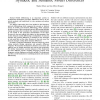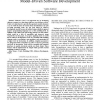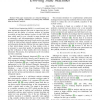MODELS
2015
Springer
9 years 8 months ago
2015
Springer
—Changing the development environment can have severe impacts on the system behavior such as the executiontime performance. Since it can be costly to migrate a software applicati...
MODELS
2015
Springer
9 years 8 months ago
2015
Springer
In any curriculum or course that teaches or emphasises the use of modelling, a critical concern is evaluating the modelling artefacts that students produce, leading to the producti...
MODELS
2015
Springer
9 years 8 months ago
2015
Springer
—Model differencing is an important activity in model-based development processes. Differences need to be detected, analyzed, and understood to evolve systems and explore alterna...
MODELS
2015
Springer
9 years 8 months ago
2015
Springer
Abstract—We present the integration of the Behavioral Coordination Operator Language (B-COOL) into the GEMOC Studio. B-COOL enables the system designer to automate the coordinati...
MODELS
2015
Springer
9 years 8 months ago
2015
Springer
—Software reuse is an important key in developing software systems in a short time with low cost and fewer errors. Traits were introduced to provide fine-grained reusable element...
MODELS
2015
Springer
9 years 8 months ago
2015
Springer
—Tailoring software processes is an activity that allows process engineers to adapt organizational software processes to the needs of particular projects. Model-driven engineerin...
MODELS
2015
Springer
9 years 8 months ago
2015
Springer
— In this paper, we present a tool named UmpleRun that allows modelers to run the textually specified state machines under analysis with an execution scenario to validate the mod...
MODELS
2015
Springer
9 years 8 months ago
2015
Springer
Abstract. The Object Constraint Language (OCL) is a central component in modeling and transformation languages such as the Unified Modeling Language (UML), the Meta Object Facilit...
MODELS
2015
Springer
9 years 8 months ago
2015
Springer
—This paper summarizes our research findings on optimizing the symbolic execution of evolving state machines using incremental analysis. I. PROBLEM AND MOTIVATION Model Driven E...
MODELS
2015
Springer
9 years 8 months ago
2015
Springer
—Software modeling is generally a collaborative activity and typically involves graphical diagrams. The Unified Modeling Language (UML) is the de facto standard for modeling obj...





